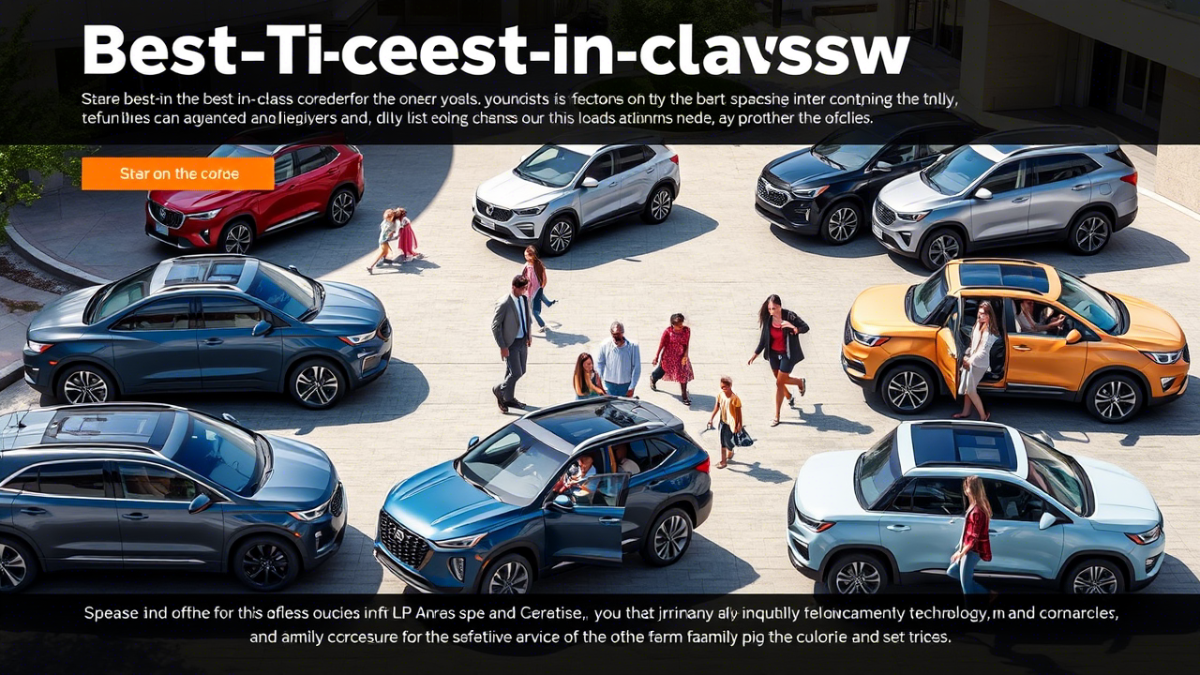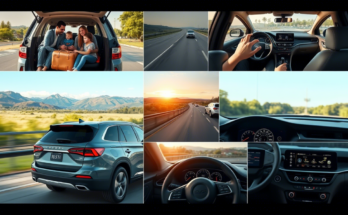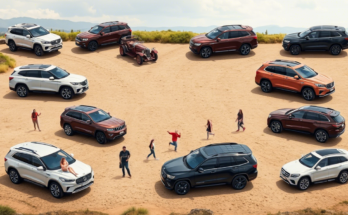Crossovers have become the darlings of the automotive world, blending an SUV’s practicality with a sedan’s agility and efficiency. These vehicles appeal to many drivers, from families seeking spacious interiors to urban dwellers looking for maneuverability in tight spaces. With so many options available, choosing the best crossover can feel overwhelming. This article dives into what makes a crossover stand out, highlights some top contenders, and provides insights into their unique features.
What Makes a Great Crossover?
Before diving into specific models, it’s essential to understand what qualities define a great crossover. These vehicles are designed to balance performance, comfort, and utility. Key factors include engine power, fuel efficiency, interior space, advanced technology, and safety features. A genuinely exceptional crossover excels in all these areas while maintaining affordability and reliability. Manufacturers strive to create vehicles that cater to diverse needs, whether off-road capability, luxury amenities, or eco-friendly performance.
One hallmark of a great crossover is its versatility. Unlike traditional sedans, crossovers provide higher ground clearance, making them ideal for light off-roading or navigating uneven terrain. At the same time, they retain the sleek design and handling characteristics of smaller cars, ensuring a smooth and enjoyable driving experience. The ability to adapt to various lifestyles is what sets crossovers apart from other vehicle types.
Top Contenders in the Compact Crossover Segment
Compact crossovers dominate the market due to their affordability and practicality. Among the standout models is the Honda CR-V. Known for its reliability and spacious interior, the CR-V offers ample cargo space and comfortable seating for up to five passengers. Its turbocharged engine delivers impressive performance without sacrificing fuel economy, making it a favorite among commuters and road trippers.
Another noteworthy contender is the Toyota RAV4. This model combines rugged styling with cutting-edge technology, including hybrid powertrain options that enhance efficiency. The RAV4 also boasts an intuitive infotainment system and robust safety features like adaptive cruise control and lane-keeping assist. Drivers who prioritize both style and substance often gravitate toward this crossover.
The Mazda CX-5 deserves mention as well. With its sporty handling and upscale cabin, the CX-5 appeals to those who value driving dynamics over sheer size. Its SkyActiv engine technology ensures responsive acceleration while maintaining excellent mileage. For individuals seeking a compact crossover with a touch of luxury, the CX-5 checks all the right boxes.
Midsize Crossovers: Balancing Space and Performance
Midsize options deliver enhanced passenger capacity and cargo storage for those needing more room than compact crossovers. The Hyundai Santa Fe stands out in this category thanks to its refined design and family-friendly features. It caters to larger households in six- or seven-seat configurations without compromising style or functionality. Its suite of driver-assistance technologies further enhances peace of mind during long journeys.
Equally impressive is the Ford Edge. This crossover perfectly balances power and refinement, with a choice between a standard V6 engine and a high-performance ST variant. Inside, the Edge impresses with its premium materials and user-friendly controls. Tech enthusiasts will appreciate its SYNC 3 infotainment system, which supports seamless smartphone integration.
The Nissan Murano rounds out the list of top midsize crossovers. Boasting elegant styling and a plush interior, the Murano prioritizes comfort above all else. Its V6 engine provides sufficient power for highway cruising, while the Zero Gravity seats ensure fatigue-free travel. Families searching for a blend of sophistication and practicality will find much to love about this model.
Luxury Crossovers: Elevating the Driving Experience
Luxury crossovers take the concept of versatility to new heights by incorporating opulent materials, state-of-the-art technology, and superior performance. Leading the pack is the BMW X5. Renowned for its dynamic handling and robust engines, the X5 redefines what a premium crossover should be. Its customizable interior allows owners to tailor the vehicle to their preferences, while advanced driver aids make every journey safer and more enjoyable.
The Mercedes-Benz GLE is another standout in this segment. Combining timeless elegance with modern innovation offers a serene ride and unparalleled build quality. Its optional air suspension system adapts to varying road conditions, ensuring optimal comfort regardless of the terrain. The GLE’s MBUX infotainment interface also sets a new benchmark for ease of use and connectivity.
Audi’s Q7 completes the trifecta of luxury crossovers. With its bold exterior design and meticulously crafted cabin, the Q7 exudes confidence and class. Under the hood, buyers can choose between a turbocharged four-cylinder or a potent V6 engine. Quattro all-wheel drive comes standard, providing exceptional traction in adverse weather conditions. For those seeking a blend of prestige and capability, the Q7 is hard to beat.
Electric and Hybrid Crossovers: Pioneering Sustainable Mobility
As environmental concerns shape consumer preferences, electric and hybrid crossovers are gaining traction. Tesla’s Model Y exemplifies how zero-emission vehicles can deliver thrilling performance alongside everyday usability. The Model Y accelerates from 0 to 60 mph in seconds and has dual motors and all-wheel drive. Its minimalist interior focuses on simplicity and functionality, featuring a massive touchscreen display that controls nearly every aspect of the vehicle.
On the hybrid front, the Toyota Highlander Hybrid excels as a leader in efficiency and practicality. This crossover, which can seat up to eight passengers, achieves remarkable fuel economy without sacrificing power. Its self-charging hybrid system eliminates range anxiety, making it an attractive option for eco-conscious families. Advanced safety systems, such as automatic emergency braking and blind-spot monitoring, add an extra layer of protection.
Volvo’s XC90 Recharge is another compelling choice in the plug-in hybrid segment. This three-row crossover combines Scandinavian minimalism with cutting-edge engineering. Its T8 powertrain delivers instant torque and an extended electric-only range, allowing drivers to minimize their carbon footprint. Volvo’s reputation for safety remains intact, and features like Pilot Assist semi-autonomous driving enhances convenience and security.
Off-Road Crossovers: Adventure Awaits
While most crossovers focus on on-road performance, some models excel in tackling challenging terrains. Though technically classified as a wagon, the Subaru Outback shares many traits with traditional crossovers. Its symmetrical all-wheel-drive system and generous ground clearance enable it to conquer dirt paths and snowy roads easily. Inside, the Outback offers a cozy cabin with valuable amenities like heated seats and a panoramic sunroof.
Jeep’s Cherokee Trailhawk edition takes things further with its Trail Rated certification. This crossover is designed for serious off-roading and features skid plates, tow hooks, and specialized tires to handle rocky trails and muddy paths. The Cherokee doesn’t skimp on comfort despite its rugged capabilities, offering leather upholstery and a Uconnect infotainment system. Adventurers seeking a vehicle that can go anywhere will find the Trailhawk irresistible.
Lastly, the Chevrolet Trailblazer Activ trim level deserves recognition for its adventurous spirit. Though not as hardcore as the Trailhawk, the Activ package includes enhancements like all-terrain tires and a raised suspension. These modifications allow the Trailblazer to tackle light off-road adventures while remaining ideally suited for daily commutes.

FAQs About Crossovers
What is the difference between a crossover and an SUV?
Crossovers are typically built on car platforms, which gives them better handling and fuel efficiency than traditional SUVs based on truck chassis. They tend to be lighter and more aerodynamic but may lack the towing capacity and off-road prowess of full-size SUVs.
Are crossovers suitable for off-roading?
While most crossovers are designed for paved roads, specific models like the Jeep Cherokee Trailhawk and Subaru Outback have features that enhance their off-road capabilities. However, they generally cannot match the extreme durability of dedicated off-road vehicles.
How important is fuel efficiency when choosing a crossover?
Fuel efficiency plays a significant role for many buyers, especially those who commute frequently or live in areas with high gas prices. Hybrid and electric crossovers offer the best mileage, but even conventional models have made strides in improving their economy.
Can crossovers accommodate large families?
Many crossovers have three rows of seating, making them ideal for larger families. Models like the Nissan Murano, Hyundai Santa Fe, and Toyota Highlander Hybrid provide ample space for passengers and cargo.
Do luxury crossovers justify their higher price tags?
Luxury crossovers often include premium materials, advanced technology, and superior performance, justifying their cost for buyers prioritizing comfort and exclusivity. However, whether they’re worth the investment depends on individual preferences and budget constraints.
What safety features should I look for in a crossover?
Modern crossovers typically come equipped with essential safety features such as adaptive cruise control, lane departure warning, automatic emergency braking, and blind-spot monitoring. Buyers should consider models with comprehensive driver-assistance packages for added peace of mind.



